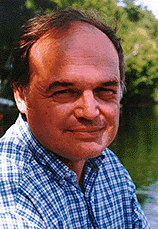George Boolos facts for kids
Quick facts for kids
George Boolos
|
|
|---|---|
 |
|
| Born | 4 September 1940 New York City, New York, U.S.
|
| Died | 27 May 1996 (aged 55) Cambridge, Massachusetts, U.S.
|
| Education | Princeton University (A.B.) Oxford University MIT (PhD, 1966) |
| Era | 20th-century philosophy |
| Region | Western philosophy |
| School | Analytic philosophy |
| Thesis | The Hierarchy of Constructible Sets of Integers (1966) |
| Doctoral advisor | Hilary Putnam |
|
Main interests
|
Philosophy of mathematics, mathematical logic |
|
Notable ideas
|
Hume's principle Nonfirstorderizability The Hardest Logic Puzzle Ever |
|
Influences
|
|
|
Influenced
|
|
George Stephen Boolos (born September 4, 1940 – died May 27, 1996) was an American philosopher and a logician. He was a professor at the famous Massachusetts Institute of Technology (MIT). He was known for his work in logic and the philosophy of mathematics.
Contents
Life and Education
George Boolos came from a Greek-Jewish family. He studied mathematics at Princeton University. For his final project, he wrote about Gödel's incompleteness theorems. These theorems are very important ideas in logic.
He then went to Oxford University in England. In 1966, he earned his PhD in philosophy from MIT. He was the first person to get a philosophy PhD from MIT. His teacher there was Hilary Putnam, another famous philosopher.
After teaching at Columbia University for three years, Boolos returned to MIT in 1969. He stayed there for the rest of his career.
A Clever Speaker
George Boolos was known for being a very clear and witty speaker. He once gave a lecture about a complex topic, Gödel's second incompleteness theorem, using only words with one syllable! This showed how clever he was.
He also loved puzzles. In 1993, he reached the final round of The Times crossword competition in London. He was one of the best American players ever in that competition. He even wrote a paper about "The Hardest Logic Puzzle Ever," which was created by his friend Raymond Smullyan.
Sadly, George Boolos died from pancreatic cancer on May 27, 1996.
His Work in Logic
George Boolos made many important contributions to the field of logic. He co-wrote a classic textbook called Computability and Logic with Richard Jeffrey. This book is still used by students today.
Logic of Proofs
Boolos was a pioneer in an area called "provability logic." This is a type of modal logic that studies what it means for something to be "provable" in mathematics. He wrote the first book on this topic, The Unprovability of Consistency, in 1979. His work helped people understand Gödel's second incompleteness theorem better. This theorem says that a consistent system of arithmetic cannot prove its own consistency.
Understanding Frege
Boolos was also an expert on the 19th-century German mathematician and philosopher Gottlob Frege. Frege had a system of logic that was found to have a problem called Russell's paradox. Boolos showed that if you changed one of Frege's rules, the system could work without problems. This was a big step in understanding Frege's ideas.
Plural Quantification
Another important idea Boolos worked on was "plural quantification." This is a way of thinking about groups of things in logic without saying that the group itself is a single "thing." It helps to simplify how we talk about collections in mathematics and philosophy.
Logic, Logic, and Logic
Before he passed away, Boolos chose 30 of his most important papers to be published in a book. This book, called Logic, Logic, and Logic, came out after his death. It includes many of his ideas on Frege, set theory, and Gödel's incompleteness theorems. It is considered one of his most important works.
See also
 In Spanish: George Boolos para niños
In Spanish: George Boolos para niños
- American philosophy
- Axiomatic set theory S of Boolos (1989)
- General set theory, Boolos's axiomatic set theory just adequate for Peano and Robinson arithmetic.
- List of American philosophers

